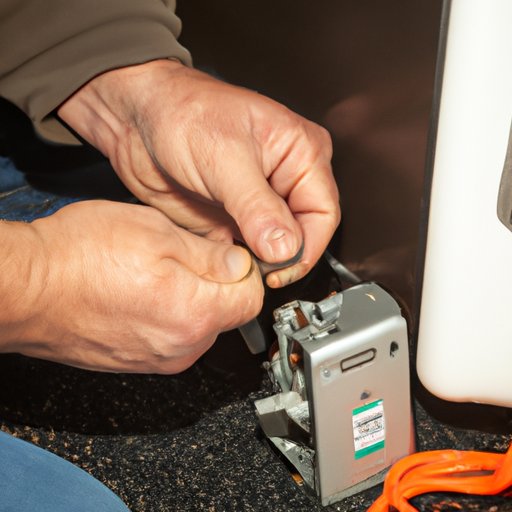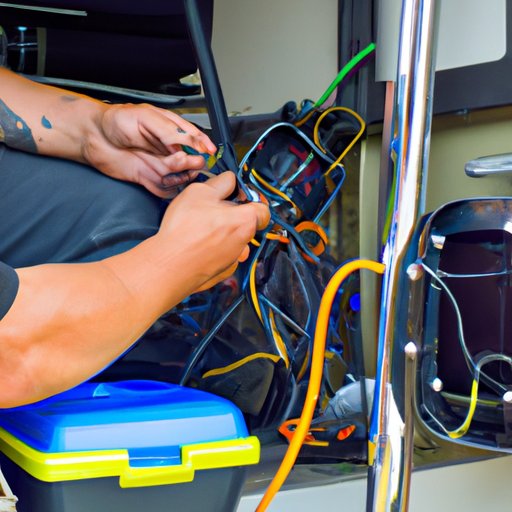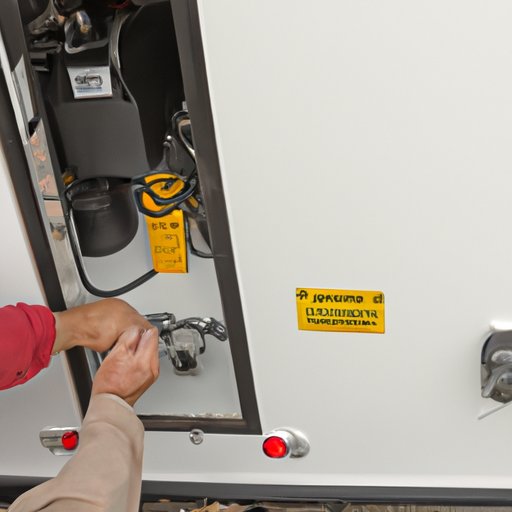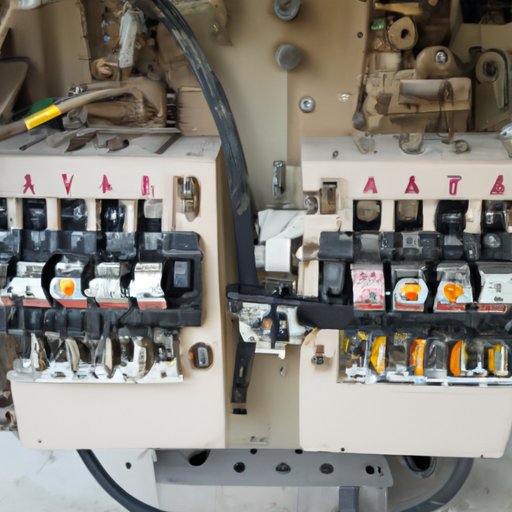Introduction
If your RV’s circuit breaker keeps tripping, it can be frustrating and confusing to figure out why. There are many potential causes for a tripping circuit breaker, ranging from overloaded circuits to short circuits or ground faults. In this article, we’ll explore the various reasons why an RV breaker may trip and provide tips and solutions on how to identify and fix the problem.

Troubleshooting Tips for Fixing a Tripping RV Breaker
Before you start trying to identify the cause of your RV’s tripping circuit breaker, there are some basic troubleshooting steps you should take. These steps will help you narrow down the possible causes and give you a better chance of fixing the problem quickly and safely.
Check the Circuit and Reset the Breaker
The first step in troubleshooting a tripping circuit breaker is to check the circuit and reset the breaker. You should make sure that all devices on the circuit are turned off before resetting the breaker. If the breaker trips again after being reset, then the problem is likely not with the breaker itself, but with something else on the circuit.
Inspect Wiring and Connections
Next, inspect all of the wiring and connections on the circuit. Look for any signs of wear or damage, such as frayed wires or loose connections. Make sure that all of the connections are secure and free of corrosion. If you find any damaged wiring or connections, replace them immediately.
Look for Overloaded Circuits
Another possible cause of a tripping circuit breaker is an overloaded circuit. This occurs when too many appliances or devices are running on the same circuit at once. To prevent this, limit the number of devices on each circuit and spread the load evenly across multiple circuits. If you find that one circuit has too many devices on it, move some of them to a different circuit.
How to Identify the Cause of an RV Circuit Breaker Trip
Once you’ve ruled out overloaded circuits and checked the wiring and connections, it’s time to look for the cause of the tripping circuit breaker. To do this, you’ll need to inspect the electrical system and test the devices on the circuit.
Inspect Electrical System
Start by inspecting the entire electrical system for any signs of damage or wear. Look for frayed wires, loose connections, and other signs of wear or damage. If you find anything, replace it immediately.
Check Voltage Draw
Next, check the voltage draw on the circuit. This can be done with a multimeter. Make sure that the voltage draw is within the recommended range for the circuit. If the voltage draw is too high, then the circuit may be overloaded.
Test Devices on the Circuit
Finally, test all of the devices on the circuit. Make sure that they are all working properly and are not drawing too much power. If you find a device that is drawing too much power, consider replacing it or moving it to a different circuit.
What Causes an RV Circuit Breaker to Trip?
Now that you’ve identified the cause of the tripping circuit breaker, it’s time to look for the underlying issue. The most common causes of a tripping circuit breaker include short circuits, ground faults, and overloads.
Short Circuit
A short circuit occurs when there is a direct connection between two points in a circuit. This can happen if a wire becomes frayed or broken, or if a connection becomes loose. Short circuits can cause the circuit breaker to trip, as they draw too much current.
Ground Fault
A ground fault occurs when a live wire touches a grounded surface, such as a metal pipe or wall. Ground faults can also occur if an appliance is connected to the wrong type of outlet. When this happens, the circuit breaker will trip to protect the circuit from an overload.
Overload
An overload occurs when too many appliances or devices are running on the same circuit at once. This can cause the circuit breaker to trip, as the circuit is unable to handle the increased load. To prevent overloads, make sure to limit the number of devices on each circuit and spread the load evenly across multiple circuits.
When an RV Breaker Keeps Tripping, Look for These Common Issues
In addition to the causes mentioned above, there are several other issues that can cause a circuit breaker to trip. Some of the most common issues include corroded wires, loose connections, and overheating components.
Corroded Wires
Corroded wires can cause a circuit breaker to trip. Corrosion can occur when moisture enters the wiring and causes the insulation to break down. If you find any corroded wires, replace them immediately.
Loose Connections
Loose connections can also cause a circuit breaker to trip. Make sure to inspect all of the connections on the circuit and tighten any loose ones. If you find any damaged connections, replace them immediately.
Overheating Components
Finally, overheating components can cause a circuit breaker to trip. If a component is drawing too much power, it can cause the circuit breaker to trip to protect the circuit from an overload. Check all of the components on the circuit and make sure that none of them are drawing too much power.
Five Reasons Why Your RV’s Breaker Keeps Tripping
Now that you know what causes an RV breaker to trip, it’s time to look at the five most common reasons why your RV’s breaker keeps tripping:
Too Many Appliances on the Same Circuit
If you have too many appliances plugged into the same circuit, it can cause the circuit breaker to trip. To prevent this, limit the number of devices on each circuit and spread the load evenly across multiple circuits.
Outdated Wiring
Older RVs may have outdated wiring that can’t handle the load of modern appliances. If you have an older RV, consider upgrading the wiring to ensure that it can handle the load.
Bad Breakers
Sometimes, the circuit breaker itself can be defective. If the breaker keeps tripping even after you’ve checked the wiring and connections, consider replacing the breaker.
Overloaded Circuits
As mentioned above, overloaded circuits can cause the circuit breaker to trip. To prevent this, make sure to limit the number of devices on each circuit and spread the load evenly across multiple circuits.
Faulty Grounding
Finally, faulty grounding can cause the circuit breaker to trip. Make sure that all of the devices on the circuit are properly grounded. If you find any faulty groundings, replace them immediately.

Diagnosing and Repairing Electrical Problems in Your RV
Once you’ve identified the cause of the tripping circuit breaker, you can begin the process of diagnosing and repairing the problem. Here are the steps you should take:
Locate the Source of the Problem
Start by locating the source of the problem. This can be done by inspecting the wiring and connections, checking the voltage draw, and testing the devices on the circuit. Make sure to replace any damaged wiring or connections.
Replace Fuses or Breakers as Needed
If you find that the circuit breaker is defective, you’ll need to replace it. You can also replace fuses as needed. Make sure to use the correct size fuse or breaker for the circuit.
Make Necessary Repairs
Finally, make any necessary repairs. This could include replacing corroded wires, tightening loose connections, or replacing faulty groundings. Make sure to use the proper tools and safety equipment when making repairs.

How to Prevent Your RV from Electrically Overloading and Tripping Its Breakers
Now that you know how to identify and repair the problem, it’s time to look at how to prevent it from happening again. Here are some tips to help prevent your RV from electrically overloading and tripping its breakers:
Limit the Number of Appliances on a Single Circuit
To prevent overloads, make sure to limit the number of appliances on a single circuit. This will help ensure that the circuit isn’t overloaded and that the breaker won’t trip.
Upgrade Your Wiring
If you have an older RV, consider upgrading the wiring to ensure that it can handle the load. This will help prevent the circuit breaker from tripping due to an overloaded circuit.
Install New Breakers
Finally, consider installing new breakers. Newer breakers are designed to trip more quickly, which can help protect the circuit from overloads and short circuits.
Conclusion
Troubleshooting an RV breaker that keeps tripping can be a daunting task. However, with the right knowledge and tools, it is possible to identify and repair the problem. By following the tips and solutions outlined in this article, you can help ensure that your RV’s circuit breaker stays in good working order and doesn’t cause any more frustration.
(Note: Is this article not meeting your expectations? Do you have knowledge or insights to share? Unlock new opportunities and expand your reach by joining our authors team. Click Registration to join us and share your expertise with our readers.)
